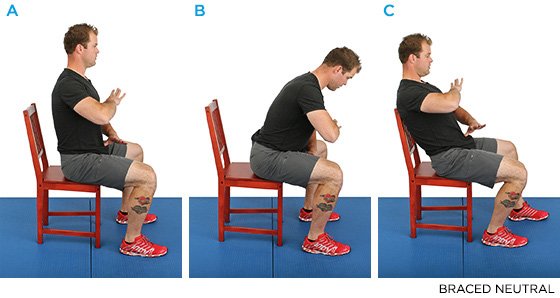You may have heard that sitting too much can be bad for your health but what’s exactly behind that idea and how can we fix it? Let’s look at how to sit at your computer to avoid pain, tightness, and fatigue.
Sitting sounds like an innocent act but as Dr. Kelly Starrett explains, there’s a lot to it, and most people don’t sit correctly which creates pain, stiffness, and fatigue as muscles become shortened and weak over time.
Sitting—like standing—is one of the most technically challenging things we do. Yet most of us are clueless when it comes to sitting well.
Studies also show risk factors from being more sedentary include diabetes, vascular issues, weight gain, depression, dementia, and even multiple cancers.
Sitting is an inevitable part of modern life so let’s dive into the mechanics of how to sit correctly. We’ll also look at how to use an exercise ball as a valuable chair option, standing desks, and more.
How to sit to avoid back pain and fatigue: 4 steps
From Dr. Starrett’s book Becoming a Supple Leopard via Bodybuilding.com:
- From standing, squeeze your butt as hard as you can
- Pull your ribcage down to align it with your pelvis and get your belly tight with at least 20% tension
- Set your head in a neutral position and screw your shoulders into a stable position
- Keep that posture and sit down
- You’re not limited to sitting perfectly upright: You can still lean forward, or lean back while maintaining a braced-neutral spine.
Here’s an image of a braced neutral proper sitting position at three different angles:

How to sit properly throughout the day
Dr. Starrett highlights some really useful tips for staying in a neutral supported position throughout the day at our computers and desks.
- Reset your sitting posture every 10-15 minutes with the steps above
- Change your position often: sitting to standing, kneeling, stretching, going for a walk, etc.
- Build awareness if you tend to round your back or overextend your back
The best way to avoid defaulting into a bad position is to stand up and get reorganized every 10-15 minutes. It’s almost impossible to remain in a good position for anything longer than that. I know—this is a pain in the ass and not always possible. But if you want to heal your body and reach your performance goals, you have to do the work. You have to make sacrifices. So pony up!
I personally use a standing desk and alternate between sitting with a braced neutral spine on an exercise ball and standing every 30 minutes.
An exercise ball is a great way to be more aware of and keep the correct sitting posture as it prevents you from slouching into the back of a chair. The ease of movement/motion being on a ball is also nice.
Here’s a look at the correct posture (A), over-rounded (B), and over-extended (C):

For an in-depth look at how the mechanics or proper sitting work, check out this video:
For more from Dr. Starrett on proper body mechanics, check out his book Becoming a Supple Leopard and website, The Ready State.
Read more 9to5Mac tutorials:
- Do’s and don’ts for cleaning your dirty iPhone (and why you should make it a habit)
- Best phone carriers: Verizon vs T-Mobile vs AT&T – is it worth making a switch?
- iPhone: How to check what apps are using precise location tracking and how to turn it off
- How to turn on end-to-end encryption for iMessage, iCloud, iPhone backups
FTC: We use income earning auto affiliate links. More.







